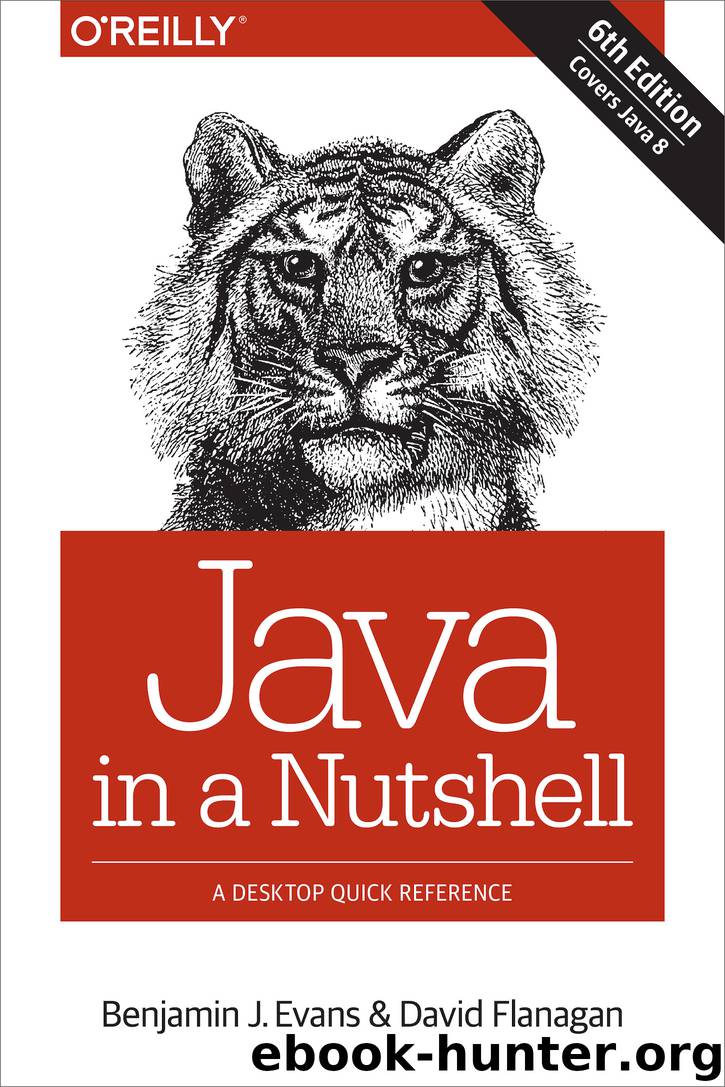Java in a Nutshell by Benjamin J. Evans David Flanagan

Author:Benjamin J. Evans, David Flanagan
Language: eng
Format: epub, mobi
Publisher: O'Reilly Media, Inc.
Published: 2014-10-14T16:00:00+00:00
Exceptions and Exception Handling
We met checked and unchecked exceptions in “Checked and Unchecked Exceptions”. In this section, we discuss some additional aspects of the design of exceptions, and how to use them in your own code.
Recall that an exception in Java is an object. The type of this object is java.lang.Throwable, or more commonly, some subclass of Throwable that more specifically describes the type of exception that occurred. Throwable has two standard subclasses: java.lang.Error and java.lang.Exception. Exceptions that are subclasses of Error generally indicate unrecoverable problems: the virtual machine has run out of memory, or a class file is corrupted and cannot be read, for example. Exceptions of this sort can be caught and handled, but it is rare to do so—these are the unchecked exceptions previously mentioned.
Exceptions that are subclasses of Exception, on the other hand, indicate less severe conditions. These exceptions can be reasonably caught and handled. They include such exceptions as java.io.EOFException, which signals the end of a file, and java.lang.ArrayIndexOutOfBoundsException, which indicates that a program has tried to read past the end of an array. These are the checked exceptions from Chapter 2 (except for subclasses of RuntimeException, which are also a form of unchecked exception). In this book, we use the term “exception” to refer to any exception object, regardless of whether the type of that exception is Exception or Error.
Because an exception is an object, it can contain data, and its class can define methods that operate on that data. The Throwable class and all its subclasses include a String field that stores a human-readable error message that describes the exceptional condition. It’s set when the exception object is created and can be read from the exception with the getMessage() method. Most exceptions contain only this single message, but a few add other data. The java.io.InterruptedIOException, for example, adds a field named bytesTransferred that specifies how much input or output was completed before the exceptional condition interrupted it.
When designing your own exceptions, you should consider what other additional modeling information is relevant to the exception object. This is usually situation-specific information about the aborted operation, and the exceptional circumstance that was encountered (as we saw with java.io.InterruptedIOException).
There are some trade-offs in the use of exceptions in application design. Using checked exceptions means that the compiler can enforce the handling (or propagation up the call stack) of known conditions that have the potential of recovery or retry. It also means that it’s more difficult to forget to actually handle errors—thus reducing the risk that a forgotten error condition causes a system to fail in production.
On the other hand, some applications will not be able to recover from certain conditions—even conditions that are theoretically modelled by checked exceptions. For example, if an application requires a config file to be placed at a specific place in the filesystem and is unable to locate it at startup, there may be very little it can do except print an error message and exit—despite the fact that java.io.FileNotFoundException is a checked exception.
Download
Java in a Nutshell by Benjamin J. Evans David Flanagan.mobi
This site does not store any files on its server. We only index and link to content provided by other sites. Please contact the content providers to delete copyright contents if any and email us, we'll remove relevant links or contents immediately.
| Coding Theory | Localization |
| Logic | Object-Oriented Design |
| Performance Optimization | Quality Control |
| Reengineering | Robohelp |
| Software Development | Software Reuse |
| Structured Design | Testing |
| Tools | UML |
The Mikado Method by Ola Ellnestam Daniel Brolund(20293)
Hello! Python by Anthony Briggs(19616)
Secrets of the JavaScript Ninja by John Resig Bear Bibeault(17889)
Dependency Injection in .NET by Mark Seemann(17854)
The Well-Grounded Java Developer by Benjamin J. Evans Martijn Verburg(17295)
OCA Java SE 8 Programmer I Certification Guide by Mala Gupta(17207)
Adobe Camera Raw For Digital Photographers Only by Rob Sheppard(16926)
Kotlin in Action by Dmitry Jemerov(16848)
Algorithms of the Intelligent Web by Haralambos Marmanis;Dmitry Babenko(15990)
Grails in Action by Glen Smith Peter Ledbrook(15158)
Test-Driven iOS Development with Swift 4 by Dominik Hauser(10312)
Becoming a Dynamics 365 Finance and Supply Chain Solution Architect by Brent Dawson(8048)
Microservices with Go by Alexander Shuiskov(7816)
Practical Design Patterns for Java Developers by Miroslav Wengner(7714)
Test Automation Engineering Handbook by Manikandan Sambamurthy(7665)
Angular Projects - Third Edition by Aristeidis Bampakos(7151)
The Art of Crafting User Stories by The Art of Crafting User Stories(6605)
NetSuite for Consultants - Second Edition by Peter Ries(6528)
Demystifying Cryptography with OpenSSL 3.0 by Alexei Khlebnikov(6304)
